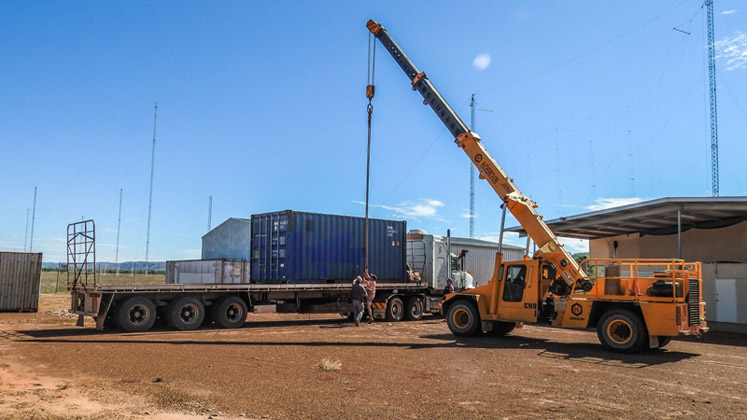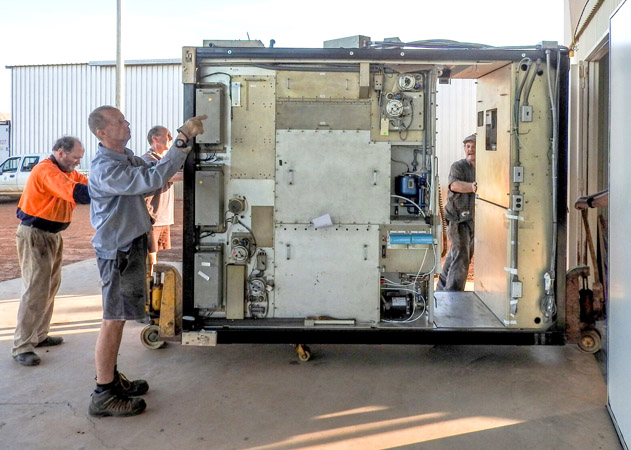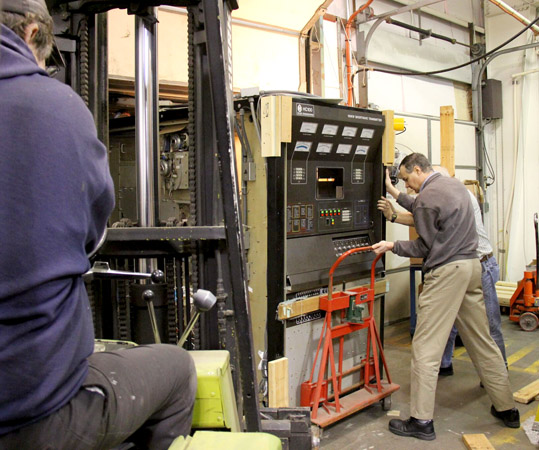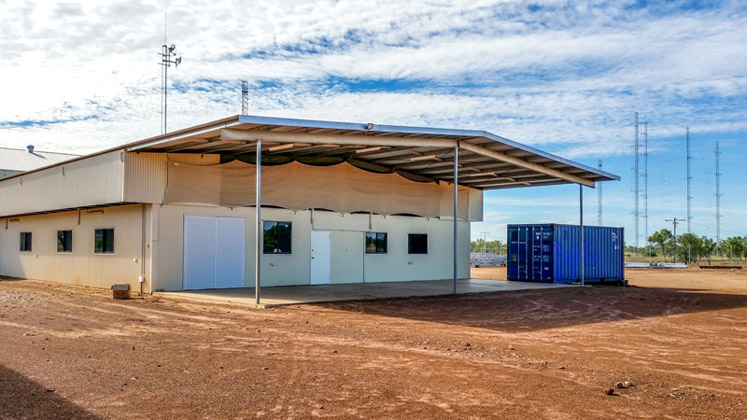MENU
(July 29, 2016 - by Harold Goerzen) A high-power shortwave transmitter that once broadcast programs around the world from Radio Station HCJB in Ecuador is now beaming the gospel message across Asia from a broadcast site in Australia.
Reach Beyond-Australia’s international broadcast facility in Kununurra added a third 100-kw transmitter on Sunday, June 26, soon after the refurbished unit arrived from partner SonSet Solutions (formerly HCJB Global Technology Center) in Elkhart, Ind.
 “It’s helping us deliver programs at the right times, better targeting individual geographic and language audiences, allowing greater flexibility in future schedule development and assisting in transmitter maintenance scheduling,” explained Derek Kickbush, media manager for the Asia Pacific Region.
“It’s helping us deliver programs at the right times, better targeting individual geographic and language audiences, allowing greater flexibility in future schedule development and assisting in transmitter maintenance scheduling,” explained Derek Kickbush, media manager for the Asia Pacific Region.
“All of this adds up to the most important thing—providing the best opportunity possible for those who have not heard or have limited access to the gospel to become growing followers of Jesus,” he said.
Brent Weeks, studio manager at the Melbourne office, said the new equipment was needed because “with 18 of the 29 languages that we broadcast aired to India and South Asia, we had run out of primetime listening hours with just two transmitters.”
Boosting Listenership
Kickbush expects that the more convenient airtimes will boost listenership, especially since many of Reach Beyond-Australia’s listeners live in rural settings, spending their daylight hours working with crops, livestock or in cottage-type industries.
 “Most will tune in during the late afternoon and early evening so the window of best opportunity is between 6 and 8 p.m. (local time),” he noted. “The addition of the third transmitter allows us to spread our programming over more separate transmissions which means we can broadcast more programs within that best listening time.”
“Most will tune in during the late afternoon and early evening so the window of best opportunity is between 6 and 8 p.m. (local time),” he noted. “The addition of the third transmitter allows us to spread our programming over more separate transmissions which means we can broadcast more programs within that best listening time.”
“The real issue is about effective and strategic program hours—not the number of broadcast hours,” Kickbush continued. “Shortwave broadcasting is costly to operate but is excellent value for the money when the size of an audience is considered and when programming is strategically directed to listeners.”
The new three-transmitter schedule presents 66¼ hours of programming per week. Included is a new 30-minute program produced in partnership with TWR, “Women of Hope.” It airs in nine Asian languages: Bangla, Burmese, Gujarati, Hindi, Indonesian Bahasa, Javanese, Oriya, Tamil and Vietnamese.
Part of Project Hannah (www.projecthannah.org), the program is designed to encourage women worldwide, helping them experience God’s love, freedom and power as they face life’s daily challenges, regardless of their cultural, social or economic situations.
Arriving in Australia
The journey taken by the new HC100 unit was a long one, according to chief engineer Steve Sutherland in Kununurra.
 Built in Elkhart in the early 1990s, the transmitter first went into service in Pifo, Ecuador, in early 1992—“the same year I arrived in Pifo,” Sutherland recalled. “And I’m the person who turned it off after its final release in Ecuador on Sept. 30, 2009.”
Built in Elkhart in the early 1990s, the transmitter first went into service in Pifo, Ecuador, in early 1992—“the same year I arrived in Pifo,” Sutherland recalled. “And I’m the person who turned it off after its final release in Ecuador on Sept. 30, 2009.”
After being in use in the South American country for up to 20 hours a day for 17 years, the unit was dismantled and prepared for shipment in early 2010. The HC100 was then transported to the factory in Elkhart where work began to overhaul it for Reach Beyond-Australia.
“The transmitter was converted to work on 50-hertz power and thoroughly cleaned,” explained Charlie Jacobson, a Reach Beyond engineer on loan to SonSet Solutions. “The worn mechanical and plumbing parts were also replaced and some of the electronics upgraded.”
The equipment, packed into a large container, left Elkhart on Feb. 29, 2016, via truck. Then it was transferred to a rail car in Chicago and transported to Los Angeles where it was loaded onto a ship at the Port of Los Angeles. It changed ships in Taiwan and Singapore before arriving at the port city of Fremantle (near Perth, Australia) on April 24. After passing inspection and customs, it was transported by truck for the 3,224-km (2,000-mile) journey to Kununurra, Western Australia, arriving in June.
“Wet weather a few days prior to the transmitter’s arrival was a concern due to the dirt roads out to the site,” Kickbush added. “However a plan B wasn’t needed because the truck raised dust as it drove the equipment to its final destination. There were the usual gremlins that needed to be overcome with technical equipment, but then came the excitement of turning it on and going through the testing process.”
Reaching Hearts for Christ
Reach Beyond-Australia CEO Dale Stagg pointed out that the international broadcast facility, which has been airing programs via shortwave since 2003, continues to play an important role in reaching the Asia Pacific Region with the gospel.
 “India, one of our priority countries, has a population of over 1.2 billion people,” he said. “Sixty percent of India’s population does not even have access to FM, so shortwave for India is still a crucial means of communication.”
“India, one of our priority countries, has a population of over 1.2 billion people,” he said. “Sixty percent of India’s population does not even have access to FM, so shortwave for India is still a crucial means of communication.”
“Our broadcast site gives us great access to the entire Asia Pacific Region,” Stagg continued. “This area has more than 4.2 billion people and many of the world’s unreached people groups.”
Source: Reach Beyond-Australia
Reach Beyond-Australia’s international broadcast facility in Kununurra added a third 100-kw transmitter on Sunday, June 26, soon after the refurbished unit arrived from partner SonSet Solutions (formerly HCJB Global Technology Center) in Elkhart, Ind.
 “It’s helping us deliver programs at the right times, better targeting individual geographic and language audiences, allowing greater flexibility in future schedule development and assisting in transmitter maintenance scheduling,” explained Derek Kickbush, media manager for the Asia Pacific Region.
“It’s helping us deliver programs at the right times, better targeting individual geographic and language audiences, allowing greater flexibility in future schedule development and assisting in transmitter maintenance scheduling,” explained Derek Kickbush, media manager for the Asia Pacific Region.“All of this adds up to the most important thing—providing the best opportunity possible for those who have not heard or have limited access to the gospel to become growing followers of Jesus,” he said.
Brent Weeks, studio manager at the Melbourne office, said the new equipment was needed because “with 18 of the 29 languages that we broadcast aired to India and South Asia, we had run out of primetime listening hours with just two transmitters.”
Boosting Listenership
Kickbush expects that the more convenient airtimes will boost listenership, especially since many of Reach Beyond-Australia’s listeners live in rural settings, spending their daylight hours working with crops, livestock or in cottage-type industries.
 “Most will tune in during the late afternoon and early evening so the window of best opportunity is between 6 and 8 p.m. (local time),” he noted. “The addition of the third transmitter allows us to spread our programming over more separate transmissions which means we can broadcast more programs within that best listening time.”
“Most will tune in during the late afternoon and early evening so the window of best opportunity is between 6 and 8 p.m. (local time),” he noted. “The addition of the third transmitter allows us to spread our programming over more separate transmissions which means we can broadcast more programs within that best listening time.”“The real issue is about effective and strategic program hours—not the number of broadcast hours,” Kickbush continued. “Shortwave broadcasting is costly to operate but is excellent value for the money when the size of an audience is considered and when programming is strategically directed to listeners.”
The new three-transmitter schedule presents 66¼ hours of programming per week. Included is a new 30-minute program produced in partnership with TWR, “Women of Hope.” It airs in nine Asian languages: Bangla, Burmese, Gujarati, Hindi, Indonesian Bahasa, Javanese, Oriya, Tamil and Vietnamese.
Part of Project Hannah (www.projecthannah.org), the program is designed to encourage women worldwide, helping them experience God’s love, freedom and power as they face life’s daily challenges, regardless of their cultural, social or economic situations.
Arriving in Australia
The journey taken by the new HC100 unit was a long one, according to chief engineer Steve Sutherland in Kununurra.
 Built in Elkhart in the early 1990s, the transmitter first went into service in Pifo, Ecuador, in early 1992—“the same year I arrived in Pifo,” Sutherland recalled. “And I’m the person who turned it off after its final release in Ecuador on Sept. 30, 2009.”
Built in Elkhart in the early 1990s, the transmitter first went into service in Pifo, Ecuador, in early 1992—“the same year I arrived in Pifo,” Sutherland recalled. “And I’m the person who turned it off after its final release in Ecuador on Sept. 30, 2009.”After being in use in the South American country for up to 20 hours a day for 17 years, the unit was dismantled and prepared for shipment in early 2010. The HC100 was then transported to the factory in Elkhart where work began to overhaul it for Reach Beyond-Australia.
“The transmitter was converted to work on 50-hertz power and thoroughly cleaned,” explained Charlie Jacobson, a Reach Beyond engineer on loan to SonSet Solutions. “The worn mechanical and plumbing parts were also replaced and some of the electronics upgraded.”
The equipment, packed into a large container, left Elkhart on Feb. 29, 2016, via truck. Then it was transferred to a rail car in Chicago and transported to Los Angeles where it was loaded onto a ship at the Port of Los Angeles. It changed ships in Taiwan and Singapore before arriving at the port city of Fremantle (near Perth, Australia) on April 24. After passing inspection and customs, it was transported by truck for the 3,224-km (2,000-mile) journey to Kununurra, Western Australia, arriving in June.
“Wet weather a few days prior to the transmitter’s arrival was a concern due to the dirt roads out to the site,” Kickbush added. “However a plan B wasn’t needed because the truck raised dust as it drove the equipment to its final destination. There were the usual gremlins that needed to be overcome with technical equipment, but then came the excitement of turning it on and going through the testing process.”
Reaching Hearts for Christ
Reach Beyond-Australia CEO Dale Stagg pointed out that the international broadcast facility, which has been airing programs via shortwave since 2003, continues to play an important role in reaching the Asia Pacific Region with the gospel.
 “India, one of our priority countries, has a population of over 1.2 billion people,” he said. “Sixty percent of India’s population does not even have access to FM, so shortwave for India is still a crucial means of communication.”
“India, one of our priority countries, has a population of over 1.2 billion people,” he said. “Sixty percent of India’s population does not even have access to FM, so shortwave for India is still a crucial means of communication.”“Our broadcast site gives us great access to the entire Asia Pacific Region,” Stagg continued. “This area has more than 4.2 billion people and many of the world’s unreached people groups.”
Source: Reach Beyond-Australia
